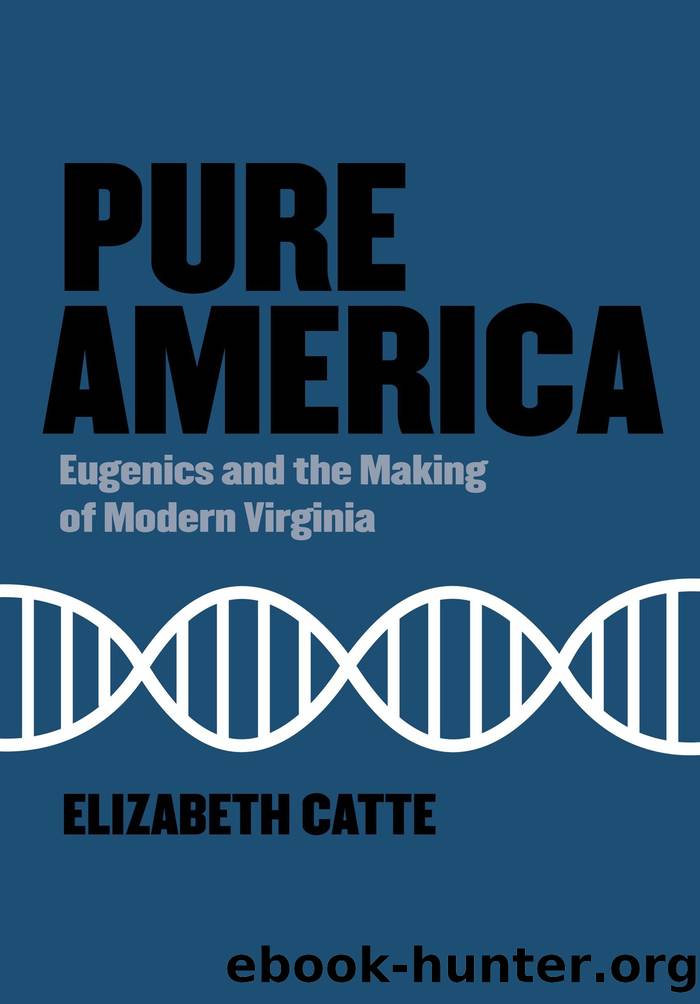Pure America: Eugenics and the Making of Modern Virginia by Elizabeth Catte

Author:Elizabeth Catte
Language: eng
Format: mobi, epub
Publisher: Belt Publishing
Published: 2021-01-15T00:00:00+00:00
In other words, the Supreme Court explained that it understood such ordinances had been motivated by a desire to maintain racial purity, and that its ruling should not be seen as obstructive to the broad aim of preventing amalgamation. By amalgamation, it meant, similar to miscegenation, the combining of races through procreation. In 1924, Virginia would create its Racial Integrity Act as its most explicit method of prevention.
The Supreme Court ruling meant that Charlottesville had to devise new ways to contain Black people geographically in order to preserve racial purity. The city leveraged other types of zoning ordinances, encouraged private contracts that produced segregation through deed restriction, manipulated the placement of utilities, and marked territory by Klan parades and, eventually, Confederate statues. But concentrating Black people into one area of the city also risked an outcome that white city leaders did not enjoy thinking about, either: that Black people would invest in their neighborhoods, find ways to grow their communities, and pass some generational wealth to their children. Limiting this potential meant restricting education, healthcare, employment, and income for Black people in Charlottesville as well. A study commissioned by the Charlottesville Low-Income Housing Coalition in 2020 found that after 1948, when the Supreme Court ruled that racial covenants were unconstitutional, the city âincreased economically restrictive zoning as a proxy for explicit racial restrictionsâ to an extent so great that these same zoning practices now impede the cityâs ability to grow.
In the 1960s, the Preston Avenue area where Klan-robed children had once frightened Black people âback into the shadowsâ became part of the target area for a city beautification campaign. Just a decade prior, the Supreme Court had affirmed the governmentâs right to utilize eminent domain solely for the purpose of beautification and redevelopment. In 1960, the mayor of Charlottesville, Thomas Mitchie, looked out at Preston Avenue and its larger Vinegar Hill neighborhood and concluded, âwe are fortunate that the worst slum area in the city lends itself beautifully to plans for urban renewal.â What Mitchie found fortunate about this arrangement was that what he called a slum was located on property that was valuable to the city. The economic and physical growth of the cityâs downtown was stagnating as suburbanization pushed residents and their business enterprises further out to the fringes of the city.
Charlottesville began demolishing the Vinegar Hill neighborhood in 1965. The city, however, deferred the most aggressive redevelopment of its new blank canvas to generations that followed in the 1980s. Separated by a span of fifteen years, future city leaders often did not connect the growth of the downtown and the creation of what we know today as the downtown mall to a racist urban renewal scheme. The passage of time, in other words, helped them achieve moral distance between what happened in the past and this new era in city development. In 2011, after decades of pressure, the city finally recognized its actions, and the city council delivered a public apology for the destruction of Vinegar Hill:
Now
Download
Pure America: Eugenics and the Making of Modern Virginia by Elizabeth Catte.epub
This site does not store any files on its server. We only index and link to content provided by other sites. Please contact the content providers to delete copyright contents if any and email us, we'll remove relevant links or contents immediately.
Machine Learning at Scale with H2O by Gregory Keys | David Whiting(3660)
Never by Ken Follett(3549)
Fairy Tale by Stephen King(2971)
Will by Will Smith(2593)
Fantastic Beasts and Where to Find Them: The Original Screenplay by J. K. Rowling(2415)
The Storyteller by Dave Grohl(2073)
It Starts With Us (It Ends with Us #2) by Colleen Hoover(2058)
Friends, Lovers, and the Big Terrible Thing by Matthew Perry(2018)
Can't Hurt Me: Master Your Mind and Defy the Odds - Clean Edition by David Goggins(2012)
The Becoming by Nora Roberts(1932)
Cloud Cuckoo Land by Anthony Doerr(1925)
New Morning Mercies: A Daily Gospel Devotional by Paul David Tripp(1821)
HBR's 10 Must Reads 2022 by Harvard Business Review(1703)
The Complete Witcher by Andrzej Sapkowski(1700)
Cytonic by Brandon Sanderson(1687)
A Short History of War by Jeremy Black(1679)
Go Tell the Bees That I Am Gone by Diana Gabaldon(1602)
Leviathan Falls (The Expanse Book 9) by James S. A. Corey(1530)
515945210 by Unknown(1525)
